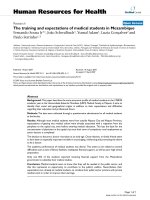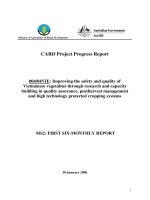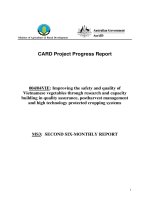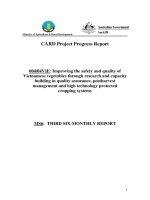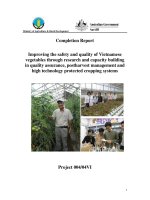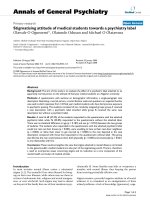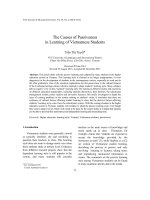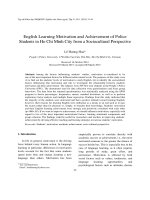Motivations and barriers of vietnamese students towards distance education
Bạn đang xem bản rút gọn của tài liệu. Xem và tải ngay bản đầy đủ của tài liệu tại đây (1.5 MB, 101 trang )
MOTIVATIONS AND BARRIERS OF
VIETNAMESE STUDENTS TOWARDS
DISTANCE EDUCATION
In Partial Fulfillment of the Requirements of the Degree of
MASTER OF BUSINESS ADMINISTRATION
In International Business
By
Mr. Tran Vu
ID: MBA03043
International University – Vietnam National University HCMC
March 2013
MOTIVATIONS AND BARRIERS OF
VIETNAMESE STUDENTS TOWARDS
DISTANCE EDUCATION
In Partial Fulfillment of the Requirements of the Degree of
MASTER OF BUSINESS ADMINISTRATION
In International Business
By
Mr. Tran Vu
ID: MBA03043
International University – Vietnam National University HCMC
March 2013
Under the guidance and approval of the committee, and approved by all its members, this thesis
has been accepted in partial fulfillment of the requirements for the degree.
Approved:
---------------------------------------------Chairperson
--------------------------------------------Adviser – Dr. Nguyen Quynh Mai
---------------------------------------------Committee member
--------------------------------------------Committee member
---------------------------------------------Committee member
--------------------------------------------Committee member
Acknowledgement
First of all, I’d like to express my great appreciation to my adviser – Dr. Nguyen Quynh
Mai. It’s my honor to work with her through this research. She had provided me countless
support including guidelines doing the research, insights about the topic, data collection,
recommendation and feedback in order to finish the thesis.
I am also grateful to the administrative staffs of the universities and my friends who
supported and helped me in collecting data, provided the insight about this topic. Their help and
inputs were very valuable to me.
Finally, it’s my biggest thanks to my parents who gave me love, strength and great
support in time and finance. They are one of the greatest motivations for me to finish the MBA
program.
2012 – MBA Thesis – Tran Vu – International University
Plagiarism Statements
I would like to declare that, apart from the acknowledged references, this thesis either
does not use language, ideas, or other original material from anyone; or has not been previously
submitted to any other educational and research programs or institutions. I fully understand that
any writings in this thesis contradicted to the above statement will automatically lead to the
rejection from the MBA program at the International University – Vietnam National University
Ho Chi Minh City.
2012 – MBA Thesis – Tran Vu – International University
Copyright Statement
This copy of the thesis has been supplied on condition that anyone who consults it is
understood to recognize that its copyright rests with its author and that no quotation from the
thesis and no information derived from it may be published without the author’s prior consent.
© Tran Vu / MBA03043 / 2013
2012 – MBA Thesis – Tran Vu – International University
Table of Content
TABLE OF CONTENT ................................................................................................. I
LIST OF FIGURES .................................................................................................... III
LIST OF TABLES ...................................................................................................... IV
ABSTRACT ................................................................................................................ VI
CHAPTER ONE – INTRODUCTION .........................................................................1
1.
RESEARCH BACKGROUND ............................................................................................................. 1
1.1.
Distance education around The World................................................................................ 1
1.2.
Distance education in Vietnam: .......................................................................................... 3
2.
RATIONALE OF THE STUDY ........................................................................................................... 5
3.
RESEARCH QUESTIONS AND OBJECTIVES ....................................................................................... 6
4.
RESEARCH SCOPE AND LIMITATION............................................................................................... 7
5.
IMPLICATION OF THE STUDY ......................................................................................................... 7
6.
RESEARCH STRUCTURE ................................................................................................................ 8
6.1.
Introduction:...................................................................................................................... 8
6.2.
Literature review................................................................................................................ 8
6.3.
Research methodology ....................................................................................................... 8
6.4.
Findings and Discussion .................................................................................................... 8
6.5.
Conclusion......................................................................................................................... 9
CHAPTER TWO - LITERATURE REVIEW ........................................................... 10
1.
DISTANCE EDUCATION ............................................................................................................... 10
2.
ADULT LEARNERS ...................................................................................................................... 12
3.
MOTIVATION ............................................................................................................................. 13
4.
BARRIERS .................................................................................................................................. 17
5.
BEHAVIORAL INTENTION ........................................................................................................... 19
6.
INFLUENCE OF DEMOGRAPHIC FACTORS TO MOTIVATIONS AND BARRIERS: ................................... 20
CHAPTER THREE – RESEARCH METHODOLOGY ........................................... 22
1.
RESEARCH PROCESS ................................................................................................................... 22
2.
RESEARCH MODEL ..................................................................................................................... 24
3.
HYPOTHESIS .............................................................................................................................. 26
4.
QUALITATIVE METHOD .............................................................................................................. 26
5.
QUANTITATIVE METHOD ............................................................................................................ 27
5.1.
Measurement ................................................................................................................... 27
5.2.
Questionnaire design ....................................................................................................... 30
5.3.
Data collection method .................................................................................................... 30
2012 – MBA Thesis – Tran Vu – International University
i
6.
DATA ANALYSIS ........................................................................................................................ 30
CHAPTER FOUR – FINDINGS & DISCUSSION .................................................... 32
1.
SAMPLE DEMOGRAPHIC .............................................................................................................. 32
1.1.
Motivation ....................................................................................................................... 34
1.2.
Barriers ........................................................................................................................... 34
2.
RELIABILITY ANALYSIS .............................................................................................................. 35
3.
FACTOR ANALYSIS ..................................................................................................................... 37
3.1.
Motivations ...................................................................................................................... 37
3.2.
Barriers ........................................................................................................................... 41
3.3.
Behavioral intention......................................................................................................... 44
4.
CORRELATION BETWEEN BEHAVIORAL INTENTION AND MOTIVATIONS, BARRIERS ....................... 44
5.
DIFFERENCE AMONG SUBGROUPS ............................................................................................... 50
5.1.
Motivation ....................................................................................................................... 50
5.2.
Barriers ........................................................................................................................... 52
CHAPTER FIVE – CONCLUSION ........................................................................... 56
REFERENCES ............................................................................................................ 58
APPENDIX .................................................................................................................. 63
2012 – MBA Thesis – Tran Vu – International University
ii
List of Figures
Figure 1 - Percentage of undergraduates enrolled in a distance education course/degree
program in U.S. ...........................................................................................................................2
Figure 2 - Number of students attending online program at HCMUS ...............................4
Figure 3 - Elements of the Self-determination theory ..................................................... 16
Figure 4 - Research process ........................................................................................... 23
Figure 5 - Research model ............................................................................................. 24
Figure 6 - Percentage of Students' Experience in Distance Education ............................. 33
Figure 7 - Motivation levels over Age ............................................................................ 51
Figure 8 - Motivation level over Gender ........................................................................ 51
Figure 9 - Motivation levels over Experience in Distance education .............................. 52
Figure 10 - Barrier level over Gender ............................................................................ 53
Figure 11 - Barrier level over Age ................................................................................. 54
Figure 12 - Barrier level over Experience in Distance Education.................................... 55
2012 – MBA Thesis – Tran Vu – International University
iii
List of Tables
Table 1 - Top 5 University/College in U.S. of online learner enrollment (Aug, 2009) ......3
Table 2 - Motivational factors of Grabowski & Curtis (1991) and Keller (1991) ............ 14
Table 3 - Measurement of Motivations and Barriers ....................................................... 28
Table 4 - Details of age and gender of respondents ........................................................ 32
Table 5 - Frequency of major fields ............................................................................... 33
Table 6 - Top ten highest motivations ............................................................................ 34
Table 7 - Top ten highest barriers .................................................................................. 35
Table 8- Reliability analysis result ................................................................................. 36
Table 9 - Rotated Factor Matrix of component Motivation ............................................. 38
Table 10 - Motivations of Vietnamese students towards Distance Education .................. 40
Table 11 - Rotated Factor Matrix of component Barrier ................................................. 41
Table 12 - Barriers of Vietnamese students towards Distance education ........................ 43
Table 13 - Factor Matrix of Behavioral Intention ........................................................... 44
Table 14 - Behavioral intention of learners towards Distance education ......................... 44
Table 15 - Correlations between Barriers and Motivations ............................................. 47
Table 16 - Relationship between Behavioral Intention and Motivation/Barrier ............... 49
Table 17 - Total variance explained of Motivations ....................................................... 63
Table 18 - Total variance explained of Barriers .............................................................. 64
Table 19 – Motivation significance by Age .................................................................... 65
Table 20 – Motivation significance by Gender ............................................................... 66
Table 21 – Motivation significance by Experience in Distance education....................... 67
Table 22 - Tukey test of Motivation among Experience in Distance Education .............. 68
2012 – MBA Thesis – Tran Vu – International University
iv
Table 23 - Barriers significance by Experience in Distance Education ........................... 69
Table 24 - Tukey test of Barriers significance by Experience in Distance Education ...... 72
Table 25 - Barriers significance by Gender .................................................................... 73
Table 26 - Barriers significance by Age ......................................................................... 74
Table 27 - Tukey test of Barriers significance by Age .................................................... 77
2012 – MBA Thesis – Tran Vu – International University
v
Abstract
Distance education has a long history in over the World. Thank to the modern
technology, especially the Internet, there are many great and useful applications for it. Distance
education is also provided by few universities in Ho Chi Minh City although there are a lot of
difficulties and challenges while implementing the program. Distance education, with many
advantages, begins to be a good channel for everyone to follow. In order to have a high quality
distance education program in Vietnam, there are a lot of concerns. One of the concerns is about
the learners. Therefore, this research is going find out the motivations and barriers of Vietnamese
students towards the distance education. Base on the result of this research, distance education
designers, instructors, and even students will have their own points of view of the current
motivation and barriers of Vietnamese students, then they could have appropriate modifications
in order to make distance education program better.
Quantitative and qualitative method was used to do this research. While the qualitative
method was used to explore the potential motivational and barriers factors, the quantitative
method used the survey method to collect mass information. A survey instrument was distributed
to 250 students who were following the distance education program in Ho Chi Minh City.
There were six motivation factors and six barrier factors found. The correlation between
motivation factors and barrier factors was also found although some was not strong. Moreover,
research also found that motivations and barriers also had the significant influence to the
behavioral intention of the learners.
Keywords: distance education, online learning, Vietnamese students, motivation, barrier,
behavioral intention.
2012 – MBA Thesis – Tran Vu – International University
vi
This page is intentionally left blank.
Chapter One – Introduction
1. Research background
1.1. Distance education around The World
Information technology, computers, Internet and its applications have changed the World
recently. There are a lot of areas that apply that modern technology effectively from military,
Government to hospital, business companies, and even retail stores. That includes the education field.
One of the most important applications is the online education.
Online education is an innovation in learning. It has a lot of advantages such as:
Pay less in tuition fee and books.
Flexible class schedule.
Save money and time on commuting to the campus.
Able to learn anywhere, any time.
The United State of America, with its powerful and latest technology, is one of the leading
countries in provide online learning program. It also invests a lot of money into this area. In 2009, the
U.S. President Barack Obama pledged $500 million in federal funds for the creation of new online
course and material. The online education in U.S. has a long history. It’s already started in the mid1970s. At that time, the software developers created some programs that allowed students to access to
the course information or material via the network easily. However, due to the limitation of the
technology at that time, the course was not fully online yet. It only had some simple functions such as:
material delivery via local network, local email and some other simple administrative actions. Later
then, in the 1980s, the online collaborative learning using computer conference started to emerge.
Using computer conferencing systems, students were able to interact synchronously and faculty began
1
to adopt group learning activities (Harasim, 2000). The invention of Internet and WWW in 1990s made
the revolution in many areas, including education. It increases the flexibility of material delivery
method, higher interactivity between learners and instructors, easier to access to online resources, etc.
In the United States, less than 10 states had online education programs in 1992. By 2004, all 50
states had some form of online learning programs available at the college level (Lynch, 2004).
According to Radford (2011), during the 2002 – 2003 school years, 36% of public school districts
enrolled a total of more than 328,000 students in technology-based distance education courses. Most
reviews of education trends show a dramatic increase in both the capacity and use of technology in our
schools. In fact, at least 22 states had established “virtual” schools by the 2004 – 2005 school-years.
The below figure shows the change of percentage of undergraduates enrolled in a distance education
course/degree program by years.
25
20
15
Enrolled in a distance education
course
Enrolled in a distance education
degree program
10
5
0
1999-2000
2003-2004
2007-2008
Figure 1 - Percentage of undergraduates enrolled in a distance education course/degree program in U.S.
2
In 1989, the University of Phoenix became the first institution to fully launch an online program
to offer both Bachelor’s and Master’s degree. It’s one of the reasons that University of Phoenix is the
university has the largest number of online learners. The success of University of Phoenix could also be
seen through the money that they used for the marketing of online education. In 2009, it’s $130 million.
No.
University/College
Number of online enrollment
1
University of Phoenix
443,000
2
Miami Dade College Florida
54,094
3
Ohio State University, Main campus
52,568
4
Arizona State University, the Tempe Campus
51,481
5
University of Minnesota, Twin Cities
50,883
Table 1 - Top 5 University/College in U.S. of online learner enrollment (Aug, 2009)
Recently, Harvard University and Massachusetts Institute of Technology has found a $60million non-profit enterprise named edX (www.edx.org) that features learning designed specifically for
interactive study via the web. Based on a long history of collaboration and their shared educational
missions, the founders are creating a new online-learning experience with online courses that reflect
their disciplinary breadth.
1.2. Distance education in Vietnam:
Although online learning has appeared in Vietnam for a long time in the form of English
training via website, it has not had much developed recently. In Ho Chi Minh City, there are only few
universities have the distance education in their programs. Even some top universities do not provide
the distance education such as University of Technology, University of Economics, etc.
3
Open University (OU) or University of Science (HCMUS) is one of the universities that provide
distance education program for the Bachelor Degree. While HCMUS only provides the bachelor degree
for Information Technology, OU provides a more diversified program including Information
Technology, Business Administration, Finance – Banking, Accounting, Economics Law, English, etc.
OU is the first university in Vietnam has the distance education program since 1993. Up to now, OU
has more than 3.000 students graduated and more than 18.000 students attending the distance education
programs (Trung Tâm Đào Tạo Từ Xa - Đại Học Mở TP.HCM, 2012).
800
700
600
500
400
300
200
100
0
2006
2007
2008
2009
2010
2011
Figure 2 - Number of students attending online program at HCMUS
Although HCMUS launched the distance education program later than OU, the number of
students increase gradually, especially in 2011. There are nearly 700 students, nearly triple times the
previous year (Office of Academic Affairs, HCMUS). That is the signal that distance education is
getting known by Vietnamese learners. It’s one of the right and appropriate channel for them to obtain
the knowledge beside the traditional education.
4
2. Rationale of the study
There are a lot of difficulties in delivering a good quality distance education program in
Vietnam. It’s not only the infrastructure, but also the quality control. There are a lot of top famous
universities in Vietnam not provide distance education. It, however, is clear to see that more
universities are considering offering that program to learners recently. It does not only increase the
opportunity to learners, especially for ones who are not able to follow the traditional program, but also
increases the competitive advantages of the universities. It is able to attract more adult learners who
want to seek for a higher degree but they do not have enough time to commute to the campus, or they
may not live near the campus.
On the other hand, there are also evidences that Vietnamese are getting familiar with the
distance education. They may find the advantages of online learning towards the traditional educations
such as:
Flexibility in class schedule. It’s very helpful for people who are full-time workers or
have odd job shifts.
Saving time to commute to the campus. This also helps to save the money on gasoline.
Saving money on books, accessories, etc.
Sharpening the learners’ soft-skills since they are on their own in organizing study.
Having classmate that are from various geographic locations, allows for an exciting
exchange of social and culture information and expands the network.
In general, distance education in Vietnam is still in the very beginning phase comparing to other
countries’’. In order to have a high quality distance education in Vietnam, the issues are not only
coming from the universities, but also from the learners. Therefore, it becomes the motivation to do this
5
research in order to let the universities have more insight about the learners and meet the learners’
demand of distance education. The universities may refer to the result from this research to have some
changes in the strategy and operations in order to launch a high quality online program and increase its
reputation.
3. Research questions and objectives
Although there have been a lot of researches for the distance education on over the World, there
are not many papers or researches in Vietnam, especially related to learners. Therefore, the main
objective of this paper is to take the first step to investigate the barriers and motivations of Vietnamese
learners towards the distance education. There are two main concerns of this research: the motivations
and the barriers of Vietnamese learners. Therefore, this paper is going to answer the question: What are
the barriers and motivations of Vietnamese online learners? They are, in specific:
To define the motivations’ and barriers’ components of Vietnamese students towards the
distance education program.
To assess motivations and barriers of Vietnamese students towards the distance
education.
To evaluate the influence of motivations, barriers of Vietnamese students towards
distance education to Behavioral intentions.
To define the influence of demographic factors to motivations and barriers of
Vietnamese students.
To give suggestions to program designers to improve the quality of distance education
program, or lecturers to modify teaching method that could fit to the expectations of
students.
6
4. Research scope and limitation
Due to the time constraint and limited resources, this research will only focus on the learners’
point of view in order to investigate their perceptions and expectations to the online learning program.
It’s the background to define the motivation and barriers of Vietnamese learners. This paper will not
discuss about the program designer or the instructor’s point of view. Therefore, it cannot define all
kinds of motivation and barriers of Vietnamese learners.
Although there are a lot of distance education programs or online courses in Vietnam, the target
objects of this research are limited to:
1. Distance education program (Master and Bachelor’s degree), not a single online course.
It’s provided by Vietnamese University, both local and international programs.
2. Geography: Ho Chi Minh City.
5. Implication of the study
From that result, it could give the suggestions for
Distance education program designer: to have some appropriate modifications to the
current program or to launch a program that fits Vietnamese online learners’
characteristic and meet their expectations.
Instructor: to have an appropriate teaching methodology that could transfer the
knowledge to the learners in the most effective way and give the best result.
Learner: to have a new point of view towards online learning and consider if distance
education is an effective educational channel in Vietnam.
7
6. Research structure
6.1. Introduction:
The part will be about the introduction of online learning around the World and in Vietnam.
From the current facts of online learning in Vietnam, it will state the current issues that motivate the
author to do this research. The research objectives will also be defined clearly in this part, together with
the research scope and limitation.
6.2. Literature review
This part will give the definitions and discussions about four terms: “Distance education”,
“Adult learners”, “Motivation” and “Barrier”. The agreement or argument of many authors will be also
discussed here. Moreover, it also reviews the influence of demographic factors to Motivations and
Barriers.
6.3. Research methodology
Research process and research model will be in this part. It’s about the steps in conducting and
doing this research such as how a questionnaire is formed, what the data collection method is, etc.
Moreover, it also states how the data will be analyzed in order to have the findings for this research.
6.4. Findings and Discussion
This part will contain the findings of the research based on the analyzed data. It is a
straightforward commentary exactly of what is found. Interpreting the findings and discussion will also
be put here. This part will be going to answer the research questions that were raised in the first part.
8
6.5. Conclusion
Base of the results and discussion, some recommendations or suggestion for relevance will be
given. Moreover, it will contain the further research or directions for further investigations to fill in
gaps of this research.
9
Chapter Two - Literature Review
1. Distance Education
Currently, there are there main terms that are used interchangeably: distance education (or
distance learning), e-learning and online learning (or online learning). There are so many definitions for
them. The differences are coming from the way of learning, material delivery, technology and even
personal perception (Moore, Dickson-Deane, & Gaylen, 2011). However, in this research, I just focus
to the original definitions.
Distance education is the oldest terms. It’s referred to the education that is provided through the
distant geographic. It’s applied for people who live in the remote area such as mountain or countryside.
It’s very hard to go to a “physical” school. As computers became involved in the delivery of education,
a proposed definition identified the delivery of instructional materials, using both print and electronic
media (Moore M. , 1990). Thanks to the modern technology, current distance education does not only
refer to different geographic, but also in time. In general, distance education is an education form that
occurs between two parties (learners and instructors); it’s held at different times and/or places, uses
varying forms of instructional materials (Moore, Dickson-Deane, & Gaylen, 2011).
There are a lot of argument and conflicts in defining term e-learning. It may originate during the
1980’s, within the similar time frame of another delivery mode – online education. Nichols (2003)
defined e-learning as strictly being accessible using technological tools such as web-based, webdistributed or web-capable. With this definition, e-learning would not exist if Internet technology was
not invented. Therefore, Ellis (2004) disagreed with Nichols to give another definition. Ellis said that elearning did not only covers content and instructional methods delivered via CD-ROM, Internet or
Intranet (Benson, A.; Elliot, D.; Grant, M.; Holschuh, D.; Kim, B.; Kim, H., 2002) but also includes
10
audio, video tape, satellite broadcast and interactive TV (Clark, 2002). Triacca, Bolchini, Botturi, &
Inversini (2004) made it more complicated by adding that e-learning was a type of online education.
On the other hand, online learning is described by most authors as access to learning experience
via the use of some technology (Benson, 2002; Carliner, 2004; Conrad, 2002). It’s the more recent
version of distance education which improves access to educational opportunities for learners described
as both non-traditional and disenfranchised (Benson, 2002; Conrad, 2002). Moreover, it’s not only the
accessibility to the education through the Internet, but also its convenient features such as flexibility
and ability to promote varied interactions (Ally, 2004; Hitltz & Turoff, 2005; Oblinger & Oblinger,
2005). Online learning could be either fully online program or hybrid program based on a mix of online
and face-to-face strategy (Kumarawadu, 2009). Moreover, an online learning program must have at
least 80% of content that is delivered through the Internet (Allen & Seaman, 2011).
Although there are a lot of similarities and differences of those three terms, there is only one
purpose among them. That is providing the education to people who cannot go to a “physical” school.
It gives the learning opportunity for individuals. Thanks to the improvement of technology and the
appearance of Internet, there have been a lot of advantages compare to the traditional education. In
general, before the age of Internet, distance education used to be the form that leaners and instructors
sat at different places and communicated through radio system. Then with the involvement of modern
technology, instructional material is not only delivered via printed version but also by electrical
versions such as CD-ROM, video and audio tape, etc. That’s e-learning which stands for electrical
learning. It also includes computers and the network (Internet and Intranet). Then it became the age of
online learning which takes big advantages of the Internet and the high technology.
Therefore, in order to avoid arguments, this research will use the most general term “distance
education”. Most Vietnamese Universities may use the term “distance learning” or “distance
11
education”. They have some common points such as: instructional materials are delivered via either
printed or electrical version; it’s flexible in time and places; mixture of offline (traditional) and online
learning, etc. There is one only exceptional case of HCMUS; they provide the distance education via
Internet fully.
2. Adult learners
Since the main research object is the learners who take part in the distance education program,
it’s important to know the definition of adult learners. Although there are several definitions of adult
learners, most of them have the same baseline at the outset to establish research parameters. They are
age and experience (Kimmel & McNeese, 2006).
An adult is a fully grown person who is legally responsible for their actions, so the age of an
adult depends on their own countries. It could be older than either 16 or 18. In Vietnam, it is 18-yearold. On the other hand, the National Center for Education Statistics of the U.S. Department of
Education (NCES) defined adult learners as “adults age 16 or older and not enrolled in the 12 th grade or
below” (NCES, 2005). Another definition of adult learner is “age 25 or older with multiple
commitments, experience that contributes to their learning and goals based on well-defined needs”
(Osgood-Treston, 2001). He also subdivided adult learners into two groups (1) “those who participate
in organized learning activities (enrichment and community education)” and (2) “those who engage in
learning for academic credit”.
In general, although there are few cases that learners are younger than 18 but they already
attended the college, this research will focus on the one who is (1) 18 and older, (2) have college degree
or higher.
12
3. Motivation
The term motivation is a familiar one. The Oxford Advance Learner's Dictionary defines
“motivate somebody” is “to be the reason why somebody does something or behaves in a particular
way”. Hence, in this research, motivations mean the reasons for somebody to take part in distance
education program.
There are two important concepts related to motivation. They are intrinsic motivation and
extrinsic motivation. There have been more than 800 publications have explored the intrinsic and
extrinsic motivation dichotomy for more than two decades (Vallerand, 1997). Intrinsic motivation
refers to performing an activity for itself, in order to experience pleasure and satisfaction inherent in the
activity, while extrinsic motivation pertains to a wide variety of behaviors where the goals of action
extend beyond those inherent in the activity itself (Deci, E. L.; Ryan, R. M., 1985). An intrinsic
motivator is the source of motivation that originates inside the individual as a response to the job itself
and the circumstances surrounding its execution (Martin, 2005). On the other hand, an extrinsic
motivator is one that originates outside the individuals and which influence their behavior (Martin,
2005).
The motivations for seeking education could be one factor of the extrinsic motivators. In the
research of Kimmel & McNeese (2006), the author found several motivators based on online learners in
Canada and U.S. such as:
A desire for personal accomplishment.
A desire to be a role model for my children.
A desire to finish a degree that I began, but did not complete earlier.
A desire for knowledge/skills in this degree field.
13
